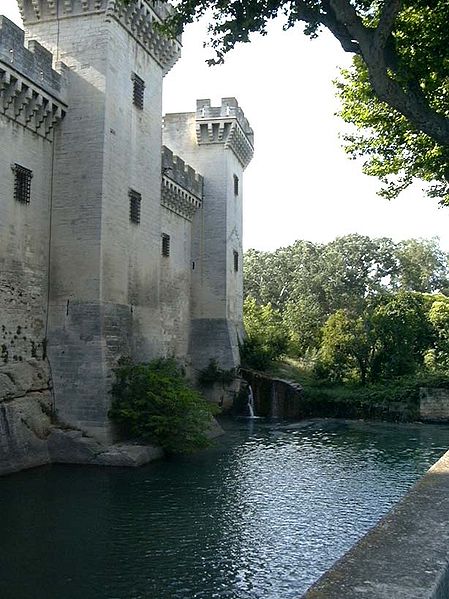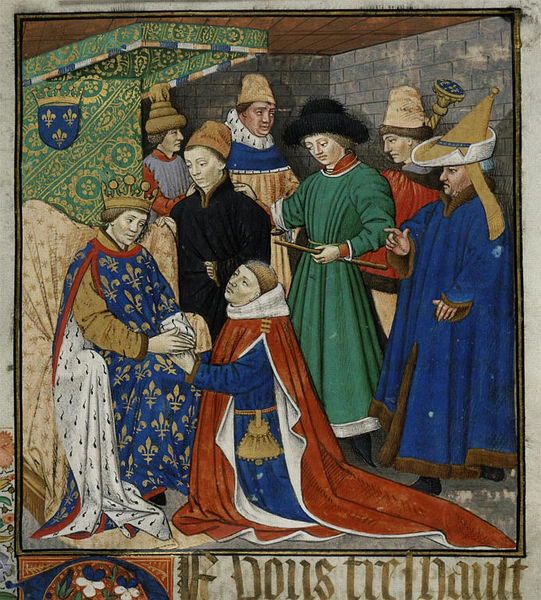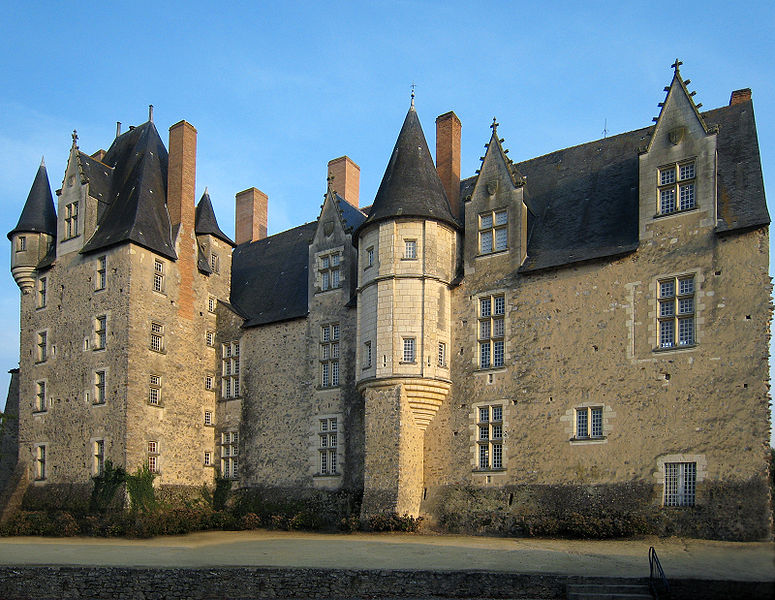<Back to Index>
- Astronomer Johannes Schöner, 1477
- Painter Alexander Adriaenssen, 1587
- King of Naples René of Anjou, 1409
PAGE SPONSOR
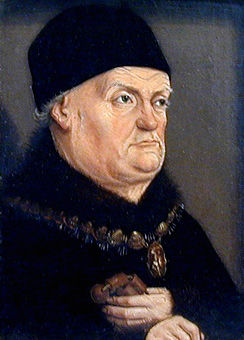
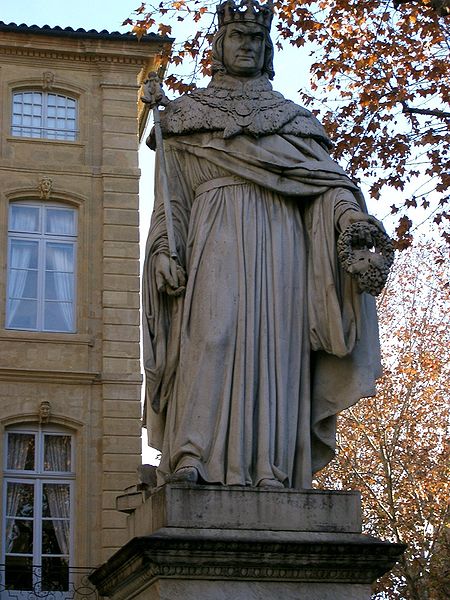
René of Anjou (Rei Rainièr in Occitan) (16 January 1409 – 10 July 1480), also known as René I of Naples and Good King René (French Le bon roi René), was Duke of Anjou, Count of Provence (1434 – 1480), Count of Piedmont, Duke of Bar (1430 – 1480), Duke of Lorraine (1431 – 1453), King of Naples (1438 – 1442; titular 1442 – 1480), titular King of Jerusalem (1438 – 1480) and Aragon (1466 – 1480) (including Sicily, Majorca, Corsica). He was the father of the English queen Margaret of Anjou, wife of King Henry VI of England and a key figure in the Wars of the Roses.
René was born in the castle of Angers, and was the second son of Louis II of Anjou, King of Sicily (i.e. King of Naples), and of Yolande of Aragon. He was the brother of Marie of Anjou, who married the future Charles VII of France and became Queen of France.
Louis II died in 1417, and his sons, together with their brother - in - law, afterwards Charles VII of France, were brought up under the guardianship of their mother. The elder, Louis III, succeeded to the crown of Sicily and to the duchy of Anjou, René being known as the Count of Guise. By his marriage treaty (1419) with Isabella, elder daughter of Charles II, Duke of Lorraine, he became heir to the Duchy of Bar, which was claimed as the inheritance of his mother Yolande, and, in right of his wife, heir to the Duchy of Lorraine.
René, then only ten, was to be brought up in Lorraine under the guardianship of Charles II and Louis, cardinal of Bar, both of whom were attached to the Burgundian party, but he retained the right to bear the arms of Anjou. He was far from sympathizing with the Burgundians, and, joining the French army at Reims in 1429, was present at the coronation of Charles VII. When Louis of Bar died
in 1430 René came into sole possession of his duchy, and in the
next year, on his father - in - law's death, he succeeded to the duchy of
Lorraine. But the inheritance was claimed by the heir male, Antoine de Vaudemont, who with Burgundian help defeated René at Bulgneville in
July 1431. The Duchess Isabella effected a truce with Antoine de
Vaudemont, but the duke remained a prisoner of the Burgundians until
April 1432, when he recovered his liberty on parole on yielding up as
hostages his two sons, John and Louis of Anjou. His title as duke of Lorraine was confirmed by his suzerain, Holy Roman Emperor Sigismund, at Basel in 1434. This proceeding roused the anger of the Burgundian duke, Philip the Good,
who required him early in the next year to return to his prison, from
which he was released two years later on payment of a heavy ransom. He
had succeeded to the throne of the Kingdom of Naples through the deaths of his brother Louis III and of Joan II,
queen of Naples, the last of the earlier dynasty. Louis had been
adopted by her in 1431, and she now left her inheritance to René. The marriage of Marie of Bourbon, niece of Philip of Burgundy, with John, duke of Calabria, René's eldest son, cemented peace between the two princes. After appointing a regency in
Bar and Lorraine, he visited his provinces of Anjou and Provence, and
in 1438 set sail for Naples, which had been held for him by the Duchess
Isabel. René's captivity, and the poverty of the Angevin resources due to his ransom, enabled Alfonso V of Aragon,
who had been first adopted and then repudiated by Joan II, to make some
headway in the kingdom of Naples, especially as he was already in
possession of the island of Sicily. In 1441 Alfonso laid siege to
Naples, which he sacked after a six month siege. René returned
to France in the same year, and though he retained the title of king of
Naples his effective rule was never recovered. Later efforts to recover
his rights in Italy failed. His mother Yolande, who had governed Anjou
in his absence, died in 1442. René took part in the negotiations
with the English at Tours in 1444, and peace was consolidated by the marriage of his younger daughter, Margaret, with Henry VI of England at Nancy. René
now made over the government of Lorraine to John, Duke of Calabria, who
was, however, only formally installed as Duke of Lorraine on the death
of Queen Isabella in 1453. René had the confidence of Charles
VII, and is said to have initiated the reduction of the men - at - arms set
on foot by the king, with whose military operations against the English
he was closely associated. He entered Rouen with him in November 1449, and was also with him at Formigny and Caen. After his second marriage with Jeanne de Laval, daughter of Guy XIV, Count of Laval, and Isabella of Brittany,
René took a less active part in public affairs, and devoted
himself more to artistic and literary pursuits. The fortunes of his
house declined in his old age: in 1466, the rebellious Catalonians offered
the crown of Aragon to René, and the Duke of Calabria,
unsuccessful in Italy, was sent to take up the conquest of that
kingdom. However, he died, apparently by poison, at Barcelona on
16 December 1470. The Duke of Calabria's eldest son Nicholas perished
in 1473, also under suspicion of poisoning. In 1471, René's
daughter Margaret was finally defeated in the Wars of the Roses. Her husband and her son were killed and she herself became a prisoner who had to be ransomed by Louis XI of France in 1476. René II, Duke of Lorraine,
Rene's grandson and only surviving male descendant, was gained over to
the party of Louis XI, who suspected the king of Sicily of complicity
with his enemies, the Duke of Brittany and the Constable Saint-Pol. René
retired to Provence, and in 1474 made a will by which he left Bar to
his grandson René II, Duke of Lorraine; Anjou and Provence to his nephew Charles, count of Le Maine.
King Louis XI seized Anjou and Bar, and two years later sought to
compel René to exchange the two duchies for a pension. The offer
was rejected, but further negotiations assured the lapse to the crown
of the duchy of Anjou, and the annexation of Provence was only
postponed until the death of the Count of Le Maine. René died on
10 July 1480 in Aix - en - Provence. He was buried in the cathedral of Angers. His charities having earned him the title of "the good." He founded an order of chivalry, the Ordre du Croissant, which preceded the royal foundation of St Michael, but did not survive René. The King of Sicily's fame as an amateur painter formerly
led to the optimistic attribution to him of many paintings in Anjou and
Provence, in many cases simply because they bore his arms. These works
are generally in the Early Netherlandish style,
and were probably executed under his patronage and direction, so that
he may be said to have formed a school of the fine arts in sculpture,
painting, goldsmith's work and tapestry. He employed Barthélemy d' Eyck as both painter and varlet de chambre for most of his career. Two of the most famous works formerly attributed to René are the triptych of the Burning Bush of Nicolas Froment of Avignon, in the cathedral of Aix, showing portraits of René and his second wife, Jeanne de Laval, and an illuminated Book of Hours in the Bibliothèque nationale, Paris. Among the men of letters attached to his court was Antoine de la Sale, whom he made tutor to his son, the Duke of Calabria. He encouraged the performance of mystery plays; on the performance of a mystery of the Passion at Saumur in 1462 he remitted four years of taxes to the town, and the representations of the Passion at Angers were carried out under his auspices. He exchanged verses with his kinsman, the poet Charles of Orléans. René was also the author of two allegorical works: a devotional dialogue, Le Mortifiement de vaine plaisance (The Mortification of Vain Pleasure, 1455), and a love quest, Le Livre du Cuer d'amours espris (The Book of the Love - Smitten Heart, 1457). The latter fuses the conventions of Arthurian romance with an allegory of love based on the Romance of the Rose. Both works were exquisitely illustrated by his court painter, Barthélémy d'Eyck. Le Mortifiement survives in eight illuminated manuscripts. Although Barthélémy's
original is lost, the extant manuscripts include copies of his
miniatures by Jean le Tavernier, Jean Colombe, and others. René
is sometimes credited with the pastoral poem Regnault and Jeanneton, but this was more likely a gift to the king honoring his marriage to Jeanne de Laval. Le Livre des tournois ("tournament book"; Traicte de la Forme de Devis d'un Tournoi) ca. 1460 describes rules of a tournament. The most famous, and earliest, of the many manuscript copies is kept in the Bibliothèque Nationale, Paris (MS Fr 2695). This is, unusually for a de luxe manuscript, on paper, and painted in watercolour. It may represent drawings by Barthélemy d'Eyck,
intended as preparatory only, which were later illuminated by him or
another artist. There are twenty-six full and double page miniatures. The description given in the book is different from that of the pas d'armes held at Razilly and Saumur; conspicuously absent are the allegorical and
chivalresque ornamentations that were in vogue at the time. René
instead emphasizes he is reporting on ancient tournament customs of
France, Germany and the Low Countries, combining them in a new
suggestion on how to hold a tournament. The tournament described is a melee fought by two sides. Individual jousts are only briefly mentioned.

